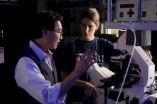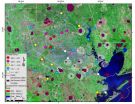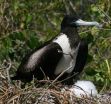Digging deep for ways to curb ammonia emissions
2010-09-29
(Press-News.org) Dairy farmers can greatly reduce ammonia emissions from their production facilities by injecting liquid manure into crop fields below the soil surface, according to research by the U.S. Department of Agriculture (USDA).
These findings, which resulted from a study conducted by soil scientist April Leytem and agricultural engineer David Bjorneberg with USDA's Agricultural Research Service (ARS), could help Idaho dairy farmers increase nitrogen capture in the soil and protect air quality from agricultural ammonia emissions. ARS is USDA's principal intramural scientific research agency.
The scientists work at the ARS Northwest Irrigation and Soils Research Laboratory in Kimberly, Idaho, and conducted their study on four dairy farms in Idaho, a state where the number of milk cows has increased 88 percent in the last decade. They applied liquid dairy manure stored in containment lagoons either by surface broadcasting, using a rolling tine aerator to incorporate manure into the top four inches of the soil surface, or injecting the manure 12 inches below the soil surface.
Over the three-day study period, the greatest concentration of emissions was recorded during the 48 hours immediately following the manure applications, with the majority of emissions occurring within 24 hours. Surface broadcasts resulted in average ammonia concentrations of 0.17 milligrams of nitrogen per cubic meter, and shallow incorporation resulted in average
ammonia emission rates of 0.16 milligrams of nitrogen per cubic meter. Fields where manure had been amended using subsurface injection had average ammonia concentrations of 0.06 milligrams of nitrogen per cubic meter—65 percent lower than emission rates resulting from soil amendments via shallow incorporation or surface broadcast.
Leytem and Bjorneberg concluded that dairy farmers who use dairy manure to amend soils could best reduce ammonia emissions by using subsurface injection, and that immediately incorporating manure deep into the soils during its application can limit losses of manure nitrogen from ammonia volatilization.
INFORMATION:
Results from this research were published in Professional Animal Scientist.
USDA is an equal opportunity provider, employer and lender. To file a complaint of discrimination, write: USDA, Director, Office of Civil Rights, 1400 Independence Ave., S.W., Washington, D.C. 20250-9410 or call (800) 795-3272 (voice), or (202) 720-6382 (TDD).
END
ELSE PRESS RELEASES FROM THIS DATE:
2010-09-29
DURHAM, N.C. – Duke University bioengineers have not only figured out a way to sneak molecular spies through the walls of individual cells, they can now slip them into the command center -- or nucleus -- of those cells, where they can report back important information or drop off payloads.
Using silver nanoparticles cloaked in a protein from the HIV virus that has an uncanny ability to penetrate human cells, the scientists have demonstrated that they can enter the inner workings of the nucleus and detect subtle light signals from the "spy."
In order for these nano-spies ...
2010-09-29
A study conducted at Copenhagen University Hospital showed that treatment of rheumatoid arthritis (RA) with disease modifying antirheumatic drugs (DMARDs), glucocorticoids, biologic agents, or a combination of agents significantly reduced radiographic evidence of joint destruction, with a relative effect of 48%% as compared with placebo. A direct comparison between the combination of a biologic agent plus methotrexate and the combination of 2 DMARDs plus initial glucocorticoids revealed no difference. Study findings are published in the October issue of Arthritis ...
2010-09-29
Social rejection isn't just emotionally upsetting; it also upsets your heart. A new study finds that being rejected by another person makes your heart rate drop for a moment. The study is published in Psychological Science, a journal of the Association for Psychological Science.
Research has shown that the brain processes physical and social pain in some of the same regions. Bregtje Gunther Moor, Eveline A. Crone, and Maurits W. van der Molen of the University of Amsterdam and Leiden University in the Netherlands wanted to find out how social pain affects you physically. ...
2010-09-29
Results from a 12-month multi-center clinical trial did not show therapeutic benefit of abatacept over placebo in patients with non-life threatening systemic lupus erythematosus (SLE). Abatacept failed to prevent new disease flares in SLE patients tapered from corticosteroids in an analysis where mild, moderate and severe disease flares were evaluated together. Full details of the phase IIb clinical trial are published in the October issue of Arthritis & Rheumatism, a journal of the American College of Rheumatology (ACR).
The ACR estimates that 161,000 to 322,000 adults ...
2010-09-29
The Structural Genomics Consortium (SGC), an international public-private partnership that aims to determine three dimensional structures of medically important proteins, announced today the release into the public domain of its 1000th high resolution protein structure.
The 1000th structure – known as JmjD2C – belongs to a class of proteins involved in epigenetic signalling, a key research area for the SGC. Epigenetics is the study of inherited changes in gene expression caused by proteins such as JmjD2C which 'switch' genes on or off. It is believed that a better understanding ...
2010-09-29
HOUSTON, Sept. 28, 2010 – A large section of northwestern Harris County – particularly the Jersey Village area – is sinking rapidly, according to a University of Houston (UH) geologist who has analyzed GPS data measuring ground elevation in the Houston area.
Some points in Jersey Village are subsiding by up to 5.5 centimeters (about 2 inches) a year, said Shuhab Khan, an associate professor of geology at UH. Khan, along with UH geology professor Kevin Burke and former Ph.D. student and UH alumnus Richard Engelkemeir, studied a decade's worth of detailed GPS data measuring ...
2010-09-29
In comments sent to Secretary Kathleen Sebelius at the U.S. Department of Health and Human Services, AMIA (American Medical Informatics Association) called out 10 specific challenges to proposed modifications to HIPAA Privacy and Enforcement Rules. AMIA's comments, sent on behalf of its membership of 4,000 informatics professionals, detail key issues of concern related to the Notice of Proposed Rulemaking (NPRM) on HIPAA modifications, along with suggestions for models of change. The following areas were cited:
Business Associates and Subcontractors
Position: AMIA ...
2010-09-29
Although the magnificent frigatebird may be the least likely animal on the Galapagos Islands to be unique to the area, it turns out the Galapagos population of this tropical seabird may be its own genetically distinct species warranting a new conservation status, according to a paper by researchers at the Smithsonian Conservation Biology Institute, the Smithsonian's National Museum of Natural History and the University of Missouri-St. Louis published last week in the scientific journal Proceedings of the Royal Society B.
The Galapagos Islands, which once served as a scientific ...
2010-09-29
When the scientific and spiritual worlds collide, they do so in the most surprising ways. Classical meteorological and plant science has, in the last century, insisted that dew negatively affects plant life, leading to rot and fungus. But in the Judeo-Christian tradition, dew is most welcomed as an important source of vegetative and plant life, celebrated in poetry and prayer.
Now Prof. Pinhas Alpert of Tel Aviv University's Department of Geophysics and Planetary Sciences has developed an explanation for the perplexing paradox with his colleagues. According to scientific ...
2010-09-29
A study carried out by Spanish researchers has shown that the presence of chemical contaminants can interact with noise and modify, for good or for bad, the way in which work-related "deafness" – which is increasingly common among young people – manifests itself. Noise-related hearing loss is the most common occupational disease in Europe.
"Workers exposed to noise in the presence of metalworking fluids exhibit a delay in hearing alteration in comparison with those exposed only to noise at the same intensity. However, those exposed to noise in the presence of welding ...
LAST 30 PRESS RELEASES:
[Press-News.org] Digging deep for ways to curb ammonia emissions





